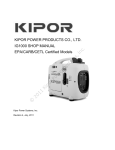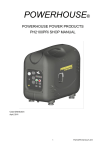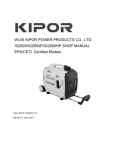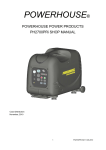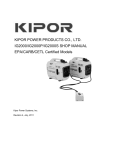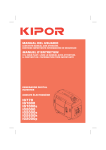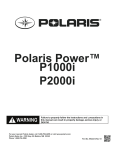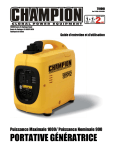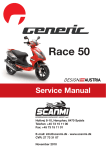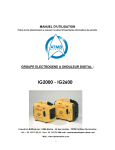Download Clarke IG1000 Specifications
Transcript
KIPOR POWER PRODUCTS CO., LTD. IG1000 SHOP MANUAL CARB and CETL Models The Coast Distribution System December, 2008 Preface This manual covers the construction, function and servicing procedure of the KIPOR IG1000. This manual is applicable to all models certified by the California Air Resources Board (CARB) and CETL built in December 2008 and onward. The construction of both generators is identical but CARB model fuel systems use certified materials. Procure the correct parts applicable to your model. Careful observance of the instructions contained in this manual will result in safe and quality maintenance and repair work. All information, illustrations, directions and specifications included in this publication are based on the latest product information available at the time of approval for printing. KIPOR POWER CO., LTD, reserves the right to make changes without incurring any obligation whatever. No part of this publication may be reproduced without written permission. ii CONTENTS 1. SPECIFICATIONS/WIRING DIAGRAM .................................................................................... 1 1.1 SPECIFICATIONS .............................................................................................................. 1 1.2 WIRING DIAGRAM ............................................................................................................. 3 2. SERVICE INFORMATION ........................................................................................................ 4 2.1 THE IMPORTANCE OF PROPER SERVICING .................................................................. 4 2.2 IMPORTANT SAFETY PRECAUTIONS .............................................................................. 4 2.3 SERVICE RULES ............................................................................................................... 5 2.4 ELECTRICAL PRECAUTIONS ........................................................................................... 5 2.5 SERIAL NUMBER AND BARCODE .................................................................................... 6 2.6 MAINTENANCE STANDARDS ........................................................................................... 7 2.7 TORQUE VALUES .............................................................................................................. 8 3. TROUBLESHOOTING.............................................................................................................. 9 3.1 GENERAL SYMPTOMS AND CAUSES.............................................................................. 9 3.2 HARD STARTING ............................................................................................................. 10 3.3 OIL LEVEL SWITCH ......................................................................................................... 13 3.4 ENGINE STOPS RUNNING.............................................................................................. 13 3.5 ENGINE SPEED UNSTABLE............................................................................................ 14 3.6 ENGINE SPEED TOO HIGH OR LOW ............................................................................. 14 3.7 SMART THROTTLE .......................................................................................................... 15 3.8 LOW OR NO AC OUTPUT ................................................................................................ 15 3.9 NO DC OUTPUT ............................................................................................................... 16 4. MAINTENANCE .................................................................................................................... 17 4.1 MAINTENANCE SCHEDULE ........................................................................................... 17 4.2 ENGINE OIL ..................................................................................................................... 18 4.3 CHECKING THE LOW OIL ALARM .................................................................................. 18 4.4 AIR CLEANER .................................................................................................................. 19 4.5 SPARK PLUG ................................................................................................................... 20 4.6 VALVE CLEARANCE ........................................................................................................ 21 4.7 FUEL TANK AND FILTER ................................................................................................. 24 4.8 FUEL PUMP AND HOSES ................................................................................................ 25 4.9 SPARK ARRESTOR.......................................................................................................... 26 5. MUFFLER ............................................................................................................................. 27 6. AIR FILTER/CARBURETOR ................................................................................................. 28 6.1 AIR FILTER REMOVAL AND INSTALLATION ................................................................... 28 6.2 CARBURETOR REMOVAL AND INSTALLATION ............................................................. 28 6.3 STEPPING MOTOR REMOVAL AND INSTALLATION ..................................................... 29 6.4 CARBURETOR EXPLODED DRAWING .......................................................................... 30 6.5 INSPECTION .................................................................................................................... 31 iii 7. CONTROL PANEL ................................................................................................................ 32 7.1 REMOVAL AND INSTALLATION ....................................................................................... 33 7.2 INSPECTION .................................................................................................................... 33 8. HOUSING/FUEL TANK ......................................................................................................... 35 8.1 HOUSING DISASSEMBLY ............................................................................................... 35 8.2 FUEL TANK ASSEMBLY ................................................................................................... 36 9. RECOIL STARTER/AIR CONDUCT COVER/IGNTION COIL/AIR CONDUCT PLATE ......... 37 9.1 DISASSEMBLY AND REASSEMBLY ................................................................................ 37 9.2 AIR CONDUCT PLATE ..................................................................................................... 38 9.3 RECOIL STARTER ........................................................................................................... 39 9.4 IGNITION COIL ................................................................................................................. 42 10. ALTERNATOR/TRIGGER ..................................................................................................... 43 10.1 ALTERNATOR ................................................................................................................. 43 10.2 INSPECTION .................................................................................................................. 43 10.3 TRIGGER ADJUSTMENT ............................................................................................... 44 11. CYLINDER COVER/ROCKER ARM ....................................................................................... 45 11.1 DISASSEMBLY/REASSEMBLY ...................................................................................... 45 11.2 INSPECTION .................................................................................................................. 46 12. CRANKCASE COVER/CAMSHAFT DRIVE CHAIN ............................................................. 47 12.1 DISASSEMBLY ............................................................................................................... 47 12.2 CRANKCASE OIL TRAY ASSEMBLY AND DISASSEMBLY ........................................... 47 12.3 CRANKSHAFT INSTALLATION ...................................................................................... 48 12.4 CRANKCASE COVER ASSEMBLY ................................................................................ 49 12.5 INSPECTION .................................................................................................................. 49 13. CRANKSHAFT/PISTON AND CONNECTING ROD ............................................................. 52 13.1 DISASSEMBLY ............................................................................................................... 52 13.2 PISTON ........................................................................................................................... 53 13.3 INSPECTION .................................................................................................................. 54 iv 1. SPECIFICATIONS and WIRING DIAGRAM 1.1 SPECIFICATIONS Dimensions and weights Model IG1000 Overall Length in (mm) 18.1 (460) Overall Width in (mm) 9.8 (248) Overall Height in (mm) 15.6 (395) Net Weight in (Kg) 30.8 (14) Engine Model KG144 Type 4-stroke,OHV, single cylinder, Gasoline engine Displacement cu in. (cc) 3.3 (53.5) Maximum horsepower/rpm 1.3/5500 Compression ratio 8.5:1 Cooling system Forced air-cooled Ignition system T.C.I Ignition timing 29°B.T.D.C Spark plug UR5 Carburetor Float type, Horizontal, butterfly valve type Air cleaner Semi-dry type Governor Electronic control Lubrication system Forced splash Oil capacity qt (L) .19 (0.22) Starting system Recoil starter Stopping system Primary circuit ground Fuel Automotive unleaded gasoline 87 octane Model KD10 Generator type Multi pole rotation Generator structure Self-ventilation drip-proof alternator Excitation Self-excitation (Magnet type) Voltage regulation system Plush width modulation Phase Three phase Rotating direction Clockwise (Viewed from the generator) Frequency regulation AC-DC-AC conversion Alternator 1 Performance Model IG1000 Maximum output AC 1.0KVA Rated output AC 0.9KVA Rated output DC 100W Rated frequency 60HZ Rated voltage AC 120V Rated voltage DC 12V Rated current AC 7.5A Rated current DC 8.3A Power factor Voltage variation rate 1.0 Momentary 10%max. Average 1.5%max. Average time 3 sec. max. Voltage stability ±1% Frequency variation rate Momentary 1%max. Average 1%max. Average time 1 sec. max. Frequency stability ±0.1% Insulation resistance 10MΩ min. AC circuit protector 8.8 A DC circuit protector 10 A Fuel tank capacity-gal (L) .69 (2.6) Operating hours 4 Noise level NL-FL @ 23’ (7 m) 60-65 dB 2 1.2 WIRING DIAGRAM 3 2. SERVICE INFORMATION 2.1 The importance of proper servicing Proper servicing is essential to the safety of the operator and the reliability of the generator. Any error or oversight made by the technician while servicing can easily result in faulty operation and/or damage to the equipment or injury to the operator. Improper servicing can cause an unsafe condition that can lead to serious injury or death. Follow the procedures and precautions in this shop manual carefully. Some of the most important precautions are stated below. 2.2 Important safety precautions Be sure you have a clear understanding of all basic shop safety practices and that you are wearing appropriate clothing and safety equipment. When performing maintenance or repairs, be especially careful of the following: • Read the instructions before you begin, and be sure you have the tools and skills required to perform the tasks safely. • Be sure that the engine is off before you begin any maintenance or repairs. This will reduce the possibility of several hazards: - Carbon monoxide poisoning from engine exhaust. - Burns from hot parts. - Injury from moving parts. • Do not run the engine unless the instructions tell you to do so. Keep your hands and clothing away from rotating parts. • To reduce the possibility of fire or explosion, exercise extreme caution when working around gasoline. Use only a nonflammable solvent, not gasoline, to clean parts. Keep cigarettes, sparks and flames away from all fuel-related parts. 4 2.3 Service rules • Use genuine KIPOR or KIPOR-recommended parts and lubricants or their equivalents. Parts that do not meet Kipor’s design specifications may damage the engine. • Use the special tools designed for the product. • Always install new gaskets, O-rings, etc. when reassembling components. • Clean parts in cleaning solvent upon disassembly. Lubricate any sliding surfaces before reassembly. After reassembly, check all parts for proper installation and operation. • Many screws used in this machine are self-tapping. Be aware that cross-threading or over tightening these screws will strip the threads and ruin the hole. • Use only metric tools when servicing this engine. Metric bolts, nuts and screws are not interchangeable with non metric fasteners. The use of incorrect tools and fasteners will damage the engine. 2.4 Electrical precautions • Hold the connector body to disconnect the connector. Do not disconnect by pulling the wire harness. To disconnect the locking connector, be sure to unlock first, and then disconnect. • Check the connector terminals for bend, excessive extrusion, missing terminals, or other abnormalities before connecting the connector. • To connect, insert the connector as far as it goes. If the connector is a locking type, be sure that it is locked securely. • Check the connector cover for breakage and check whether the connector female terminal is not opened excessively. Then, connect the connector securely. Check the connector terminal for rust. Remove the rust using an emery paper or equivalent material before connecting the connector. • Set the harness clips in the specified places of the frame securely, and secure the wire harnesses. • Clamp the cables securely. • Clamp the wire harnesses securely so that they do not interfere with the rotating parts, moving parts and hot parts. • Route and connect the wire harnesses properly. Be sure that the harnesses are not slack, twisted or pulled overly taut. • Route the wire harnesses properly so that they do not contact sharp edges and corners and the end of the bolts and screws on the body. 5 • If a wire harness must contact the end of the bolts or screws or sharp edges and corners, protect the contact part of the harness with a loom or by winding with electrical insulating tape. If the wire harness has a grommet, set the grommet securely. • Take care not to pinch the wire harnesses during installation of a part. If a wire harness has damaged insulation, repair by winding with electrical insulating tape. • When using an electrical tester like a volt/ohm meter or clamp on meter, read the manufacturer’s operating instructions carefully before operating the tester. Be sure that the tester battery is fully charged and the meter is functioning properly 2.5 Serial number and bar code The generator serial number identifies your particular unit and is important when ordering parts and accessories. The bar code is used by your dealer and Coast Distribution for warranty administration. It identifies the date of manufacture. In this example, 060313 indicates the generator was manufactured on June 6, 2006. The generator serial number is stamped on the engine block to the right of the oil dipstick. The bar code label is placed on the bottom of the generator. It is additionally found on the inside cover of the operator’s manual and on the carton. 6 2.6 Maintenance standards Part Item Engine Maximum speed without load Cylinder Sleeve I.D. Skirt O.D Piston Pin bore I.D. Piston pin O.D Height Ring side clearance 1st ring Ring end clearance Width Height Ring side clearance Piston ring 2nd ring Ring end clearance Width Height Ring side clearance Oil ring Ring end clearance Width Small end I.D Connecting rod Big end I.D Crankshaft Valves Crank pin O.D. Valve clearance Stem O.D. Intake Exhaust Intake 7 Standard(mm) Service limit 5500±100 rpm — 1.712-1.714 in 43.500-43.520 mm 1.711-1.712 in 43.460-43.480 mm 0.3937-0.3940 in 10.002-10.008 mm 0.3934-0.3937 in 9.994-10.000 mm 0.030-0.031 in 0.77-0.79 mm 0.0008-0.0024 in 0.02-0.06 mm 0.0039-0.0098 in 0.10-0.25 mm 0.063-0.071 in 1.60-1.80 mm 0.038-0.039 in 0.97-0.99 mm 0.0008-0.0024 in 0.02-0.06 mm 0.0039-0.0098 in 0.10-0.25 mm 0.071-0.078 in 1.80-2.00 mm 0.053-0.058 in 1.35-1.48 mm 0.0008-0.0067 in 0.02-0.17 mm 0.0079-0.1180 in 0.20-0.30 mm 0.3942-0.3946 in 2.00-2.40 mm 0.3942-0.3946 in 10.012-10.024 mm 0.5911-0.5915 in 15.015-15.025 mm 0.5896-0.5899 in 14.975-14.985 mm 0.0031-0.0039 in 0.08-0.10 mm 0.0039-0.0059 in 0.10-0.15 0.156-0.157 in 1.716 in 43.595 mm 1.707 in 43.350 mm 0.3955 in 10.050 mm 0.3920 in 9.950 mm 0.028 in 070 mm 0.0059 in 0.15 mm 0.0314 0.80 mm 0.055 in 1.40 mm 0.0354 in 0.90 mm 0.0059 in 0.15 mm 0.0314 0.80 mm 0.063 in 1.60 mm 0.049 in 1.25mm 0.0090 in 0.23 mm 0.0354 in 0.90 mm 0.3965 in 1.80 mm 0.3965 in 10.070 mm 0.5937 in 15.080 mm 0.5866 in 14.900 mm --------0.1535 in Exhaust Valve spring Guide I.D. IN/EX Free length IN/EX Cam wheel Cam height O.D Camshaft Camshaft bearing I.D. I.D(Rocker arm) Rocker arm O.D.(Rocker arm shaft) I.D.(Rocker arm shaft bearing) Spark plug Ignition coil Gap Primary side Second side Resistance Air gap Pulse coil (Trigger) Resistance 3.965—3.980 mm 0.1557-0.1562 in 3.955—3.970 mm 0.1575-0.1579 in 4.000—4.012 mm 0.925 in 23.5 mm 1.101-1.103 in 27.97-28.03 mm 0.1963-0.1967 in 4.988-4.996 mm 0.1976-0.1988 in 5.02-5.05 mm 0.1575-0.1579 in 4.000-4.012 mm 0.1574-0.1579 in 3.988-3.996 mm 0.1574-0.1579 in 4.000-4.012 mm 0.024-0.028 in 0.6—0.7 mm 0.8—1.3 Ω 15 —21 kΩ 0.020-0.0295 in 0.5-0.75 mm 80~130Ω 3.900 mm 0.1540 in 3.900 mm 0.2598 in 4.060 mm 0.866 in 22 mm 1.062 in 26.97 mm 0.1949 in 4.950 mm 0.2008 5.10 mm 0.2598 in 4.050 mm 0.1590 in 3.950 mm 0.1594 in 4.050 mm — — — — — — — Part Item Type Standard (Ω) Ignition winding Outer charging winding Sub winding Main winding Resistance Green-Yellow/Green 0.50-0.70 Resistance Blue--Blue 0.16-0.20 Resistance Resistance White—White Black—Black 0.25-0.35 2.0-3.0 2.7 Torque values Item Specification Connection rod bolt Spark plug Flywheel nut M5X0.8X25 M10X1.0X13 M10X1.25 M5 Bolt, nut Tightening torque Ft lb. N·m 5.9-7.4 8-10 11-13 48-52 4.4-6.0 6-8 M6 Blot, nut 5.9-7.4 Standard torque Note: Use standard torque values for fasteners that are not listed in this table. 8 8-10 3. Troubleshooting This troubleshooting section contains troubleshooting trees organized by common groups of symptoms. Some testing information is contained in these sections. The following chapters of this manual focus on individual components and sub assemblies which will give you the assembly and reassembly procedures along with detailed specifications and testing procedures. 3.1 General symptoms and possible causes Engine does not start or hard starting Engine speed does not stabilize, too high or too low Fuel filter clogged Clean Fuel tank tube clogged Clean Fuel switch clogged Clean Carburetor faulty Readjust and clean Ignition coil faulty Inspect and replace Spark plug faulty Inspect and replace Trigger faulty or trigger clearance Inspect and replace faulty Spark plug cap looses Fix it securely Low oil alarm faulty Inspect and replace Ignitor faulty Inspect and replace Ignition winding faulty Inspect and replace Throttle opening fault Set in fully close or half close position Carburetor faulty Adjust and/or disassemble and clean Throttle control motor (stepping Inspect and replace motor) faulty Inverter unit faulty Inspect and replace Valve clearance misadjusted Readjust 9 3.2 Hard starting No fuel Check the fuel level in the tank. Add fuel and restart the engine. Sufficient fuel Loosen the drain screw and check whether fuel reached the float chamber and the oil level. Abnormal Check the fuel lines for blockage. Normal Dry Remove the spark plug and check for wet or fouled electrode. Check for blockage in the carburetor intake port and nozzle. Clean the electrode and restart, Ensure the choke is not closed. If flooding is severe, check the carburetor float valve. Wet No spark or Install the spark plug and ground weak spark the electrode. Check the spark. Perform the troubleshooting ignition system Normal Install a compression gauge in the spark plug hole and check the cylinder compression by pulling the recoil starter rope several times Low cylinder compression 1. Check the valve clearance 2. Check for carbon deposits in the combustion chamber. 3. Check for worn guides and seals. 4. Check for worn piston, piston ring or cylinder. Normal compression Install the spark plug securely. Restart the engine according to the starting procedure. ■ Cylinder compression check 1. Remove the spark plug cap and spark plug. 2. Install a compression gauge in the spark plug hole. Pull the recoil starter rope several times with force and measure the cylinder compression. Cylinder compression 80 psi/0.55Mpa 10 C. Ignition system ■ Fill in oil to the demanded level. ■ Use the genuine spark plug A7RTC. ■ Spark plug inspection 1. Disassemble spark plug 2. Install spark plug onto spark plug cap. 3. Set the oil switch to the “ON” position. Ground the negative (—) electrode (i.e. threaded part) of the spark plug against the shroud and pull the recoil starter rope to check the spark plug. Normally you should see the spark jump the electrode gap when the plug is firing. ■ Don’t pull the recoil starter while touching the high tension wire with wet hands. High voltage generates, which is very dangerous. ■ Fire may be caused if fuel spilled around the spark plug, so make sure that you test after draining off fuel completely. ■ Fuel inside cylinder will be burnt if the spark plug is near the hole, so please turn off the engine first. Pull the recoil starter several times to release the unborn gas in the cylinder. 11 3.2 Hard Starting Continued Measure the spark plug gap and perform the spark plug test. Gap: 024-028 in (0.6—0.7mm) No spark Perform the spark test again using a Good spark new spark plug Replace the spark plug No spark Remove the control panel. Perform Good spark spark test with a new ignition module. Replace the ignition module No spark Check the engine switch Good spark Replace the engine switch No spark Disconnect the low oil alarm and perform spark test Good spark Replace the low oil alarm No spark Check the resistance of motor ignition winding Abnormal Replace the motor stator Normal Check the trigger Abnormal Normal Check the ignition coil resistance and high pressure cable, high pressure insulation cap. Replace the trigger or readjust trigger clearance Abnormal Replace the ignition coil Normal Inspection or replace wire harness. 12 3.3 Engine oil level is low, but engine does not stop. (Defective oil switch) Drain out oil completely, disconnect alarm No continuity connection wire, and check the continuity Replace the oil level alarm between alarm outlet terminal and ground. Continuity Reset the alarm connection wire, disconnect No continuity Repair or replace the wire ignition module and check the continuity harnesses between the plug orange wire and ground. Continuity Ignition module fault: replace module. 3.4 Engine stops running (Throttle is at the correct position) Check the oil level and oil alarm Oil alarm Fill in oil and restart the engine Sufficient oil Check whether there is enough fuel in the fuel tank. No fuel Add fuel and restart the engine Sufficient fuel Check the fuel switch and fuel filter for blockage No blocked Check the fuel supply line for blockage Blocked Clear the fuel switch and fuel filter Blocked Clear or replace the fuel supply line No blocked Check the carburetor nozzles for blockage Blocked Clean or replace carburetor Not blocked Check seal between inlet gasket and carburetor heat insulation block Abnormal Normal Measure the cylinder compression Abnormal Normal Check the trigger clearance Abnormal Normal Perform the throttle control system test 13 Tighten gasket. nuts and/or replace 1. Check the valve clearance 2. Check the carbon deposit in combustion chamber 3. Check the piston, piston ring and cylinder for damage Readjust the trigger clearance 3.5 Engine speed can’t increase or unstable (choke is at the correct position) Blocked Check the air filter element for blockage Clear the air filter element No blocked Abnormal Check the valve clearance Readjust the valve clearance Normal Remove the spark plug and check the electrode clearance for carbon deposit Abnormal Clear electrode, adjust clearance or replace the spark plug Normal Check the blockage carburetor and nozzle for Blocked Disassemble and clear No blockage Check sealing of inlet line papery gasket and carburetor heat insulation block Abnormal Normal Measure the cylinder compression Abnormal Normal Screw the nut, and replace the papery gasket or heat insulation block 1. Check the valve clearance 2. Check for carbon deposits in combustion chamber 3. Check the piston, piston ring and cylinder for damage Perform the throttle control system test 3.6 Engine speed too high or too low Check the AC output Abnormal Perform the generator troubleshooting following the section onf “No or low AC output” Normal Check the throttle control motor Abnormal Normal Replace the inverter unit 14 Replace the throttle control motor 3.7 Smart system doesn’t work with zero load or engine speed doesn’t increase with Smart system on and load connected. Check the AC output Abnormal Perform the generator troubleshooting following the section on “No AC or low voltage” Normal Check the throttle control motor Abnormal Replace the throttle control motor Normal Check the Smart Throttle switch Abnormal Replace the smart Throttle switch Normal Check Smart switch connection wire Abnormal Repair or replace the wire harness Normal Replace the inverter unit 3.8 No or low AC output Is the overload indicator light ON? ON Disconnect the load, and restart the engine OFF Is the engine speed normal? Smart switch ON: 4200±100rpm OFF:5500±100rpm Abnormal Perform the throttle control system test Normal Stop the engine and check the AC receptacle Abnormal Replace the AC receptacle Normal Disconnect the main winding and sub winding (CG) 6p connector on inverter unit. Start the generator and measure the voltage between pins 1&4, 2&4, 1&2. Each reading should be at least 290 volts. Abnormal Normal Replace the inverter unit 15 1. Check and repair stator wiring harness or replace stator 2. Check rotor magnetism. If decreasing, replace the rotor 3.9 No DC output Check the engine speed Normal Abnormal Perform the throttle control system troubleshooting Abnormal Check the DC receptacle Replace the DC receptacle Normal Check the 5 amp fuse Normal Check the rectifier Abnormal Abnormal Replace the fuse Replace the rectifier Normal Measure the resistance between the two blue wires on the rectifier. Resistance: 0.16-0.20Ω Abnormal Normal The rotor loses excitation, replace the rotor 16 Check and repair the wiring harness or replace the stator 4. Maintenance 4.1 Maintenance schedule Regular service period Item perform at every indicated month or operating hour interval, Each use whichever comes first Engine Oil Air filter Check Every 3 Every 6 Every month or months or months or year or 20 Hrs. 50Hrs. 100 Hrs. 300 Hrs. ● Replace Check First ● ● ● Clean ●* Spark plug Clean-Adjust ● Spark catcher Clean-Adjust ● Valve clearance Check-Adjust ●** Fuel tank and filter Clean ●** Fuel line Check Every 2 year (Replace if necessary) Note: * Service more frequently when operating in dusty areas. ** Service by KIPOR authorized service center. 4.2 Engine oil ■ Checking for the oil level Stop the engine and check the oil level, be sure to put the engine on a flat and level surface when checking. 1. Loosen the maintenance cover screw and remove the cover. 2. Remove the oil filler cap and check the oil level. 17 3. If the oil level is low, add to the edge of the oil filler port. ■ Replace the engine oil 1. Remove the oil dipstick and oil drain bolt, drain out dirty oil. 2. Reinstall the oil drain bolt tightly. 3. Fill with fresh oil of the proper viscosity (see operator’s manual). 4. Check the oil level. 5. Tighten the oil dipstick. ■ Drain the used oil while the engine is warm. Warm oil drains quickly and completely. Avoid burns from hot oil. 4.3 Checking the low oil alarm 1. Disconnect oil alarm connector when the engine is still running, connect the two plugs, be sure that oil alarm lights and engine stops. 18 2. Stop engine, disconnect oil alarm connector, check the connector conduction, no conduct is normal. 3. Drain out the oil inside engine and check the conduction, conduct is normal. 4.4 Air cleaner Inspection/Cleaning: 1) Loosen the cover screw and remove the maintenance cover. 2) Disengage the locking tab by pushing it, and remove the air cleaner cover. 3) Remove the element from the air cleaner case. 4) Clean the element in warm soapy water, rinse and allow to dry thoroughly and allow to dry. 5) Dip the element in clean engine oil and squeeze out all the excess oil. 6) Install the air cleaner element in the air cleaner case. Clean the air cleaner rubber and the air cleaner case if necessary. Be sure that the air cleaner cover seals are set securely. 7) Install the air cleaner cover. Be sure that the air cleaner cover seals are set securely. 8 Install the maintenance cover securely. 19 Caution ■ A dirty air cleaner will restrict air flow to the carburetor, reducing engine performance. If the engine is operated in dusty areas, clean the air cleaner more often than specified in the Maintenance Schedule. ■ Never run the engine with no element or a damaged element. Engine damage will result. 4.5 Spark plug Inspection/Cleaning: 1) Remove the spark plug cap and remove the spark plug. 2) Remove carbon or other deposits with a plug cleaner or stiff ire brush. Check the sealing washer for damage. 3) Measure the plug resistance; replace the spark plug if the measure is not accord with the asked valve. Spark plug resistance 20 3~9KΩ 4) Measure the plug gap with a wire-type feeler gauge. Adjust by bending the side electrode if the measure is not accord with the asked valve. Spark plug clearance .024-.028 in. (0.6~0.7mm) Standard spark plug A7RTC 0.6-0.7 5). Install the plug finger tight to seat the washer, and then tighten with a plug wrench. Torque valve is 8.-~9.6 ft lbs, 11~13 N.m 4.6 Valve clearance Caution ■ Valve clearance inspection and adjustment must be performed with the engine cold. Inspection/Adjustment: 1) Remove the following parts: ―Front cover, control panel ―Rear cover ―Right/left side covers ―Fuel tank ―Inverter unit, engine bed ―Recoil starter, fan cover ―Inlet/Exhaust side baffle 21 2) Remove the four tighten bolts and disassemble the cylinder cover. Don’t remove the cylinder cover with excessive force as it may deform. Replace the cylinder cover if it is deformed. 3) Remove the spark plug; screw the dial indicator in the spark plug hole. Rotate the rotor in a clockwise movement and set the piston at top dead center. Caution ■ Make sure both the intake and exhaust valves are closed. 22 4) Insert a feeler gauge between the rocker arm and the valve and measure the valve clearance. Valve clearance Intake .0031-.0039 in (0.08-0.10mm) Exhaust .0039-.0059 in (0.10-0.15) mm 5) If adjustment is necessary, proceed as follows. a. Loosen the adjusting screw lock nut and adjust the valve clearance by turning the adjusting screw in or out. b. Secure the adjusting screw with a socket wrench and tighten the lock nut to the specified torque. c. After tightening the lock nut, check the valve clearance again. 23 6) Clean the liquid gasket of the cylinder block and cylinder head cover. Apply liquid gasket (Three Bond 1207B or equivalent) to the cylinder block installation surface as shown. 7) Install all parts in the reverse order of removal. 4.7 Fuel tank/Fuel filter Caution ■ Gasoline is highly flammable and explosive. You can be burned or seriously injured when handling fuel. Keep heat, sparks, and flame away. Wipe up spills immediately. Cleaning: 1) Drain the fuel from the tank and carburetor, and then remove the following parts. ―Rear cover ―Front cover and control panel ―Right/Left side cover 2) Disconnect the fuel tube from the fuel tank, and remove the fuel filter. 3) Remove the clogged foreign material from the fuel filter, and check the fuel filter for damage. Replace the fuel filter if necessary. 4) Remove the fuel tank and clean it with cleaning solvent and allow the fuel tank to dry thoroughly. 5) After cleaning, install the fuel tank and set the fuel filter in the tank. Connect the fuel tube. 6) Install the removed parts in the reverse order of removal. 7) Fill the fuel tank with gasoline and check the fuel tube for gasoline leakage. 24 4.8 Fuel pump and hoses Caution ■ Gasoline is highly flammable and explosive. You can be burned or seriously injured when handling fuel. Keep heat, sparks, and flame away. Wipe up spills immediately. 1) Drain the fuel from the tank and carburetor, and then remove the following parts. ―Rear cover ―Front cover and control panel ―Right/Left side cover 2) Make sure the negative pressure tube is firmly connected to the port on the engine block. See page 37. 3) Check the fuel tube for deterioration, cracks and gasoline leakage. If there is any abnormality in the fuel tube, replace the tube. 4) Check the diaphragm tube for deterioration, crack and oil leakage. If there is any abnormality in the diaphragm tube, replace the tube. 5) Check to see whether water or foreign material has been accumulated in the fuel pump. If there is water or foreign material accumulated in the pump, replace the fuel pump. 6) Check the fuel switch and fuel duct, blow away the foreign matter with high pressure gas with oil switch turned on. 7) After assembly, check for gasoline leakage from each part. 25 4.9 Spark arrestor Caution ■ Make sure the muffler has cooled completely before attempting any maintenance on this part. (1) Remove the rear cover (2) Disassemble the arrestor from muffler (3) Remove the carbon from the spark arrestor steel mesh with a stiff wire brush. Check for damage and replace it if necessary. (4) Install the removed parts in the reverse order of removal. 26 5. Muffler Caution ■ Muffler removal/installation must be performed with the engine cold. ● Disassembly/Reassembly 27 6. Air filter/Carburetor Caution ■ Loosen the drain oil bolt and drain out fuel before disassembly. ■ Keep heat, flame and sparks away. 6.1 Air filter removal and installation 6.2 Carburetor removal and installation 28 6.3 Stepping motor removal and installtion 29 6.4 Carburetor exploded drawing Note: With the exception of changing the main jet for altitude compensation, no adjustments to this carburetor are permitted under EPA and CARB guidelines. No repair parts will be furnished. Fork 拨叉 拨叉弹簧 Fork spring 阻风门杆 Choke valve 阻风门片 Choke plate 怠速调整限位帽 Idle adjusting cap (Fixed) Carburetor block 本体 混合比调节螺丝 Idle mixture screw (fixed) 出厂前位置已确 定,不可调节 Needle seat 针座 泡沫管 组装: Foam tube 先用压缩空气清除通 路中的脏物再安装。 注意安装方向。 控油针 组装: Oil control needle 先对端部的磨损、弹簧的动 作进行检查,再进行安装。 控油针弹簧 Oil control needle spring 主量孔 Seal ring of oil cup 油杯密封圈 组装: 先用压缩空气 Main jet 清除通路中的 脏物再安装。 浮子销 Float pin 浮子 组装: Float 安装后应当用手指触 动,对其动作确认。 油杯 Bowl 油杯锁紧螺丝密封圈 Sealing ring 油杯放油螺栓 组装: 安装后确认没有燃油 漏出。 Carburetor drain bolt 油杯螺栓 组装: 安装后确认没有燃油 漏出。 Bowl bolt 30 6.5 Inspection ● Float height Place the carburetor as the picture shows, measure the float height between float and carburetor block. Height 0.0047 in (12mm) Replace the carburetor if the float height is not the right size. ● Stepping motor Measure the resistance of stepping motor lead-out wire. Standard resistance Between 1and 3:45~55Ω Between 2 and 4:45~55Ω Replace the stepping motor if the resistance excesses the above range. 31 1 2 4 3 7. Control panel 7.1 Removal/Installation 32 7.2 Inspection a. Control panel ● AC receptacle Check the electrode contact disk inside receptacle; if it is burnt or discolored, replace for it. ● DC receptacle After checking the fuse, connect both terminals of the receptacle with a jumper wire to short. There must be continuity between the lead wire terminals with the circuit protector ON. Replace the DC receptacle if there is no continuity. ● Smart switch There should be continuity with the switch ON, and no continuity with the switch OFF. ● Ignition Module Pull off the 10P receptacle from the module, measure the resistance by connecting one testing pen with the metal outer case of engine, and the other testing pen with the 10P connector. Color Circuit unit Standard resistance Blue Primary coil of the ignition coil 0.8-1.3Ω Orange Oil level alarm Yellow Trigger coil 80-130Ω Yellow/Green Ground wire Continuity Green Igniter unit power coil winding 0.5-0.7Ω Red Engine switch There should be no continuity with correct oil level There should be no continuity with the switch ON, continuity with the switch OFF 33 ● Engine switch Check the continuity of connector, there should be continuity when the micro switch is depressed. ● Rectifier Measure the on or off (positive pressure fall) of rectifier with control potentiometer measurement should accord with the standard as shown in the chart. Positive Negative 1 1 2 3 4 OFF OFF OFF OFF OFF 2 ON 3 ON ON 4 ON OFF ON OFF 34 , the 8. Housing / Fuel tank 8.1 Housing disassembly and reassembly ● Left housing case 35 8.2 Fuel tank assembly Caution ■ Gasoline is highly flammable and explosive. You can be burned or seriously injured when handing fuel. Keep heat, sparks, and flame away. Wipe up spills immediately. Loosen the drain screw to drain the carburetor thoroughly before removal. ] 36 9. Recoil starter/ Air conduct cover/ Ignition coil/ Air conduct plate 9.1 Disassembly/Reassembly 37 9.2 Air conduct plate Disassembly/ Reassembly 38 9.3 Disassembly and reassembly of recoil starter (1) Set the spring into the starter reel, and hang the spring outer hook inside the reel groove. 39 (2) Smear lubrication grease on the starter outer shell claw, install the starter reel. Revolve the reel anticlockwise to hang the spring inner hook on the starter outer shell claw. (3) Make a “8” knot at one end of the rope, pass the other end through the reel hole. Wind the reel anticlockwise 6 turns to fix the reel. 40 (4) Pull rope through from starter outer shell hole completely; pass it through the handle and make a figure eight knot, then turn off handle cover. Loosen the reel to release tension on the spring taking care not to allow the reel to pop out. (5) Install the revolving axis, revolving axis parts and friction spring, fix it with bolts. (6) Pull the starter for several times, and check the revolving axis. 41 9.4 Ignition Coil ● Attach the two leads of tester to the primary coil plug of ignition coil, and measure the primary resistance of the ignition coil. Primary resistance 0.8—1.3Ω ● Attach one lead of the tester to each terminal of primary coil plugs of ignition coil and the other lead to the spark plug cap,then measure the secondary resistance of the ignition coil. Secondary resistance 42 15—21kΩ 10. Alternator/Trigger 10.1 Alternator Disassembly/Reassembly 10.2 Inspection (1) Ignition winding Measure the resistance between the green terminal and yellow/green terminal. Resistance 0.50-0.70Ω (2) Outer charging winding Measure the resistance between the two blue terminals. Resistance 0.12-0.15Ω (3) Sub winding Measure the resistance between the two sub winding terminals. Resistance White-white 0.25~0.35Ω (4) Main winding Measure the resistance among the terminals of the main winding. Resistance Black-black-black 2.0~3.0Ω 43 (5) Trigger Attach the two test leads to the trigger and measure the resistance. Trigger resistance 80-130 Ω 10.3 Trigger adjustment Adjust the clearance between trigger and the projection part of rotor. Trigger clearance 0.0197-0.0275 in (0.50-0.75 mm) Insert a feeler gauge between the trigger and the projection part of the rotor; loosen the trigger fixed plate bolt to adjust the clearance slightly. Never move the plastic part of trigger, to avoid it separates from the fixed plate and damages the trigger. 44 11. Cylinder cover/ Rocker arm 11.1 Disassembly/ Reassembly 45 11.2 Inspection ● Rocker arm outer diameter Standard in (mm) Service limit in (mm) 0.1570-0.1573 (3.988-3.996) 0.1555 (3.950) ● Rocker arm inner diameter of inlet/exhaust valve Standard in (mm) Service limit in (mm) 0.1575-0.1579 (4.000-4.012) 0.2598 (4.050) ● Inner diameter of rocker arm bearing Standard in (mm) Service limit in (mm) 0.1575-0.1579 4.000-4.012 0.2598 in 4.050 46 12. Crankcase cover/ Camshaft drive chain 12.1 Disassembly 12.2 Crankcase oil tray disassembly and reassembly 1. Clean any remaining gasket material from the cylinder block and crankcase oil tray. 47 2. Apply a 0.040~0.059 in (1~1.5 mm) layer of liquid gasket material [1207B or equivalent] evenly on the sealing face of the crankcase oil tray. 3. Reassemble the crankcase cover in the reverse order of disassembly. Caution Make sure to reassemble the crankcase oil tray three minutes after applying the gasket material. 12.3 Crankshaft reinstallation 1. Revolve the crankshaft slowly, placing the timing mark pointing up. 2. Install the valve tappet, move the tappet aside and then reassemble the camshaft. Note that the timing mark on the camshaft and driving gear should be oriented downward and aligned with the timing mark on the timing gear. 48 12.4 Crankcase cover assembly 1. Remove any remaining gasket material on the cylinder block and crankcase cover. 2. Apply a 0.040~0.059 in (1~1.5 mm) layer of liquid gasket material [1207B or equivalent] evenly on the cylinder block sealing face. 3. Reassemble the crankcase cover in the reverse order of disassembly. Caution Install the crankcase cover on the cylinder block 3 minutes after applying the gasket material. 4. Screw on the crankcase cover bolts slowly and tighten to the prescribed torque. 12.5 Inspection ● Inspection of the oil alarm (1) Place the oil alarm in the position shown below. There should be no continuity between the oil alarm output wire and copper ground wire. (2) Turn the oil alarm 180° and check again; there should be continuity. (3) Immerse the oil alarm completely in oil; check the float- there should be no continuity. Caution: Wait two minutes after immersing the alarm in oil before measuring. 49 ● Cam height Standard in (mm) 1.101-1.103 (27.97-28.03) Service limit in (mm) 1.062 (26.97) ● Cam inner diameter Standard in (mm) 0.1976-0.1988 (5.02-5.05) Service limit in (mm) 0.2008 (5.10) ● Camshaft outer diameter, tappet shaft outer diameter Standard in (mm) 0.1963-0.1967 (4.988-4.996) Service limit in (mm) 0.1949 (4.950) 50 ●Valve tappet inner diameter Standard in (mm) Service limit in (mm) 0.1968-0.1975 (5.000~5.018) 0.1988 (5.050) 51 13. Crankshaft/ Piston 13.1 Disassembly/Reassembly 52 13.2 Piston Assembly of piston ring Caution ● Set the manufacture label up. ● Pay careful attention not to mix the location of the 1st ring and 2nd ring. ● Check the piston ring for flexibility after installation. ● Stagger each piston ring opening 120°apart. 53 ● There may be two different kinds of piston rings for the same model generator. They can be distinguished by different manufacture labels. Don’t intermix piston rings of different manufacture on the piston. 13.3 Inspection ● Free length of valve spring Standard in (mm) Service limit in (mm) 0.925 (23.5) 0.866 (22) 54 ● Valve stem outer diameter Standard in (mm) Service limit in (mm) Intake valve 0.156-0.157 (3.965-3.980) 0.1535 (3.900) Exhaust valve 0.1557-0.1562 (3.955-3.970) 0.1535 (3.900) ● Valve guide pipe inner diameter Standard in (mm) Intake/Exhaust valve 0.1575-0.1579 (4.000-4.012) Service limit in (mm) 0.2598 (4.060) ● Clearance between valve stem and valve guide pipe Standard in (mm) Service limit in (mm) Intake valve 0.0008-0.0018 (0.020-0.047) .0039 (0.10) Exhaust valve 0.0012-0.0022 0.030-0.057 .0047 (0.12) 55 ● Cylinder inner diameter Standard in (mm) Service limit in (mm) 1.712-1.714 (43.500-43.520) 1.716 (43.595) ● Piston skirt outer diameter Standard in (mm) Service limit in (mm) 1.711-1.712 (43.460-43.480) 1.707 (43.350) ● Clearance between piston and cylinder Standard in (mm) Service limit in (mm) 0.0008-0.0024 (0.02-0.06) .0047 (0.120) 56 ● Piston skirt outer diameter Standard(mm) Service limit(mm) 57.960-57.980 57.850 ● Clearance between piston and cylinder Standard in (mm) Service limit in (mm) 0.0078-0.0165 0.020-0.042) 0.0047 (0.120) ● Side clearance of piston ring Standard in (mm) Service limit in mm) 0.0008-0.0024 (0.02-0.06) 0.0059 (0.15) ● Piston ring end clearance Locate the piston ring into cylinder with piston top, and measure the piston end clearance. Standard in (mm) Service limit in (mm) 0.0059-0.0098 (0.15-0.25) 0.0394 (1.0) 57 ● Piston ring height Standard in (mm) Service limit in (mm) st The 1 ring The 2 nd ring 0.0030-0.031 (0.77-0.79) 0.028 (0.70) 0.038-0.039 (0.97-0.99) 0.0354 (0.90) ● Piston pin outer diameter Standard in (mm) Service limit in (mm) 0.3934-0.3937 (9.994-10.000) 0.3920 9.950 ● Piston pin bore inner diameter Standard in (mm) Service limit in (mm) 0.3937-0.3940 (10.002-10.008) 0.3955 (10.050) 58 ● Clearance between piston pin and piston pin hole Standard in (mm) Service limit in (mm) 0.00008-0.00055 (0.002-0.014) 0.00314 (0.080) ● Connecting rod small end inner diameter Standard in (mm) Service limit in (mm) 0.3942-0.3946 (10.012-10.024) 0.3965 (10.070) ● Connecting rod big end inner diameter Standard in (mm) Service limit in (mm) 0.5911-0.5915 (15.015-15.025) 0.5937 (15.080) 59 ● Crankshaft neck outer diameter Standard in (mm) Service limit in (mm) 0.5896-0.5899 (14.975-14.985) 0.5866 (14.900) ● Connecting rod big end side clearance Standard in (mm) Service limit in (mm) .0039-.0236 (0.1-0. 6) 0.0315 (0.8) 60 ● Oil film clearance of connection rod big end (1) Wipe all oil from the surface of the crankshaft neck. (2) Set the plastic wire feeler at the crankshaft neck and install the connecting rod. Tighten the bolt to the prescribed torque being careful not to rotate the crankshaft. The tightening torque is 5.9-7.4 ft lb. (8-10 N.m). (3) Disassemble the connecting rod and measure the plastic wire feeler thickness. (4) Replace the connecting rod if the clearance exceeds the service limit. Standard in (mm) Service limit in (mm) 0.0012-0.0019 0.030-0.050 0.0039 0.10 61 ●Camshaft bearing inner diameter, tappet shaft bearing inner diameter (cylinder block) Service limit in Standard in mm) 0.1976~0.1988 (5.02~5.05) (mm) 0.2008 (5.10) ●Camshaft bearing inner diameter, tappet shaft bearing inner diameter (gear case cover) Service limit in Standard in mm) 0.1976~0.1988 (5.02~5.05) (mm) 0.2008 (5.10) 62 ● Bearing vibration Clean the bearing and dry it. check the clearance between crankshaft journal and connecting rod big end by rotating the bearing by hand. Replace the bearing if there is abnormal noise or vibration. 63



































































